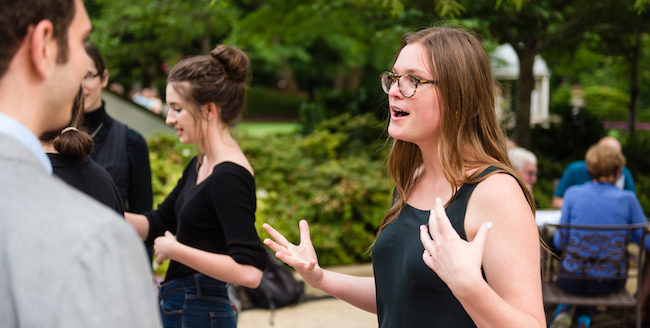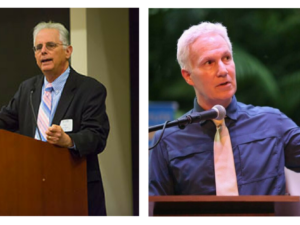By Jamie Ptacek
As CCL members, part of our work is to connect with people from a wide range of backgrounds and interests in order to build political will for climate solutions. If you have spent time engaging in dialogue over climate legislation, it is likely that you have run into this scenario: you are trying to convince someone to support your position, you have all of the facts down, and you nail the delivery—but you still meet resistance. How can we communicate more effectively with those who challenge us, in order to find common ground and move forward together?
A recent CCL communication training addressed exactly this question. In the training, called “Reframing to Move People from Resistance to Support,” guest speaker Steve Levin uses real-life scenarios to guide us through a step-by-step process of reframing a conversation. Steve, who is a CCL member, executive coach, and organizational change consultant with over 20 years of experience, sums it up like this: “When they object, we connect. When they cast blame, we reframe.” Watch the full training here, or check out the recap and snippets below:
Reframing “proposes a fresh perspective that engages us all to build a better future together,” Steve says. “We want something that will include everyone and get us moving forward, and to do that we must understand everyone’s perspective and find common ground. We have to find ways to bridge the perspective between the two of us, or else we are both going to be disappointed.” If we can reframe our argument to include someone else’s beliefs and values, Steve tells us that we will be able to “better connect to shift the dialogue and help people join us willingly and gratefully.”
Four steps to reframing
Reframing, as Steve explains it, hinges on “deeper listening, connecting on values and finding a better frame for productive collaboration.” At its core, there are four main steps to the reframing process when we are in dialogue with someone who may oppose our ideas.
- Listen more deeply. Through deep listening to someone’s objection, we will not only really hear what they are saying, but we will also discover the core values and beliefs that drive their perspective.
- Join where we can. There is always somewhere that we can find common ground and shared interests.
- Find a better frame. Using our newly identified shared values, we can reframe the problem in a way that shows how our solution speaks to their views and beliefs.
- Respond within that new frame. Converse with mutual respect to move toward the future and build solutions together to address climate change.
Practicing reframing with real life scenarios
Steve helps us practice this method through four realistic objections that people may pose to one climate solution: the Energy Innovation and Carbon Dividend Act. Each scenario follows the four step reframing process: listen to their objection, identify and affirm their underlying beliefs and values, propose a new frame or bridge that will align their values with our solution, and respond by describing how what we offer in our bill appeals to what is most important to them.
Framing freedom and responsibility
Listen to the objection: “I am a libertarian, and this is big government telling me what to do. I just don’t believe in this stuff. Let private enterprise do its thing.” How might you respond? What values are driving them? Steve suggests that freedom and personal responsibility might work here.
Affirm their values: “Yes, you want the freedom to choose and take responsibility for your choices.”
Offer a new frame: “So how can we help people to freely choose what is good for the planet?” Steve notes that asking this as a question poses it as a puzzle we need to solve together. We are not telling them what to do, but exploring with them what is possible in a creative and imaginative way.
Respond: Then, you can discuss how our proposal helps people to make their own choices because it relies on incentives, not on regulations. “It fits the facts and affirms their values,” Steve explains.
And here are a few more scenarios to demonstrate reframing.
Framing fairness
Listen to the objection: Someone may say to you, “A carbon tax is regressive and grossly unfair. Low-income people, especially people of color, need justice, not higher costs.”
Affirm their values: “You really value fairness. You don’t want people of low means to be even more disadvantaged.”
Offer a new frame: “How can we address carbon emissions in a way that makes the polluters pay the most and actually supports those of little means who use lower carbon?”
Respond: “Fortunately, studies show says that the bill will be good for the economy, decrease deaths related to fossil fuel emissions, and will hold those who cause the most pollution most accountable.”
Framing America’s economic strength
Listen to the objection: “Going alone with carbon pricing will hurt the U.S. economy, even with border adjustments. As a patriot, I want to win the race against the competition from other foreign powers.”
Affirm their values: “You value a strong economy, any solution needs to support our economic well being and we absolutely need to win the race against global warming.”
Offer a new frame: “So how can we reduce CO2 with a thriving economy and create the conditions where other countries will want to join us in this race?” In offering a new frame, Steve encourages us to think of the frame as “a bridge to where we are going and what we offer through our bill that will appeal to their values.”
Respond: “Border adjustments will give other countries an incentive and new job creation helps our economy. Dividends will encourage robust economic growth.”
To listen to the breakdowns and explanations of each reframing example, you can watch the full webinar here.
In the end, Steve explains that, “The secret of reframing is not believing, or not buying into the idea that they are on the opposite side. Our mindset is to look for commonalities and connect the dots between their values and our solution in order to turn their worry and objection into a shared problem that we have a solution to.”
With the tools of reframing that Steve has offered here, CCLers will be able to more effectively engage in dialogue with people who may not share their same perspectives in order to find common ground on climate solutions.
For more communication training, visit the Effective Climate Communication training page on CCL Community.
Jamie Ptacek is a graduate from Bowdoin College, where she studied Environmental Studies and Earth and Oceanographic Science and was involved in climate related activism. She currently resides in her hometown in Lewisburg, PA, where she is spending as much time outside as she can, teaching yoga and meditation, and working on several different climate justice campaigns.






